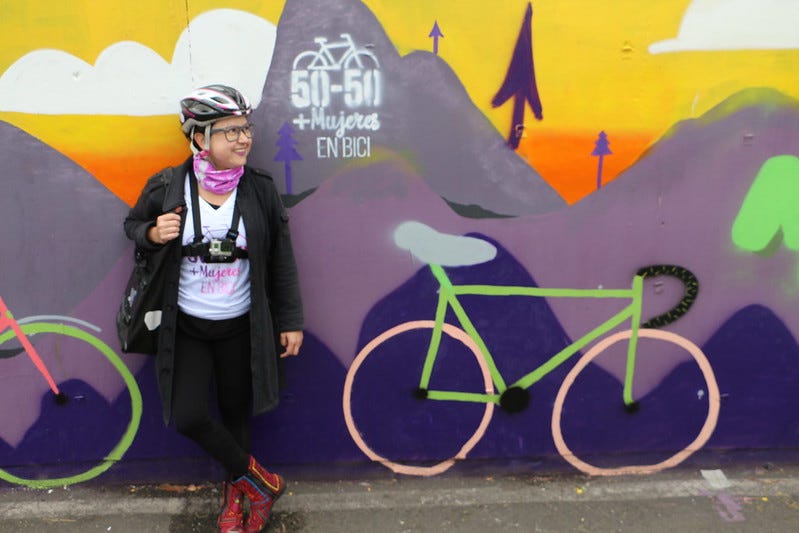Welcome to Just Two Things, which I try to publish daily, five days a week. Some links may also appear on my blog from time to time. Links to the main articles are in cross-heads as well as the story.
#1: Making cities safer for women
Bogota is something of an urban pioneer, having been one of the first cities to introduce bus rapid transit systems to increase access to work for poorer residents.
So it’s interesting to read about what they’re now doing to open up the city for women.
According to the New Economics Foundation blog, it is a triple-headed approach.
First, they have a public policy goal of gender equality in cycling use. At the moment 25% of Bogota cyclists are women (similar to London); the initiative helps to ensure that investments in cycling take gender into account. But this also has a wider effect:
As a result, city officials, cycling campaigners, feminist activist groups and local women are working together to shine a light on broader gender inequalities in society, which inevitably manifest in cycling. By simply asking – and truly listening to – women about their experiences cycling or just being out and about, officials have become more aware of some of their blind spots when it comes to creating inclusive public spaces and transport systems.
Image: Secretaria Distrital de la Mujer, Bogotá.
Lesson two is related to this: community engagement. Once you start thinking about cycling, you also start thinking about integrated services:
people also need safe places to stop and rest where there’s no pressure to spend money, particularly in light of the increasing privatisation of public space. Stakeholders in Bogota are demanding a network of cycling infrastructure with integrated services like benches, water fountains, public toilets, safe cycle parking and air pumps.
This is important because trips that are related to care are much more likely to be made by women than men—22% of women’s cycle trips are to collect someone or drop them off, compared to 6% of men’s. Integrated services also help people making long trips and people who are new to cycling.
The third lesson is to ensure that women and girls feel safe, and this also involves listening:
Since 2015, Bogota has been conducting gender safety audits, which UN Women recommend as best practice to make cities safer for women and girls. Bogota was the first city to do gender safety audits of cycle routes to learn more about how safe women feel while cycling in the city.
And at the same time, the city has been investing in campaigns that try to address some of the reasons that women feel unsafe: Bogota’s District Secretary of Women has been investing in campaigns to address machismo, patriarchy and gender-based violence in public space.
There’s more background on this policy approach at Impakter.
#2: The global surge of protest
The American academic Noah Smith is on a bit of roll at the moment, and I could have included a couple of his recent pieces here. But his discussion of the rolling wave of protest worldwide, which started in 2019 and accelerated, despite lockdown, into 2020, is the more distinctive.
We in the chattering classes spent much of the latter part of that year thinking about the protests, writing about them, theorizing about them, even visiting or joining them... We felt like we were witnessing something historic, but we couldn’t tell what we were looking at.
His piece runs through the different reasons that this might be happening now. They fall into three broad categories: economic, political or technological. His call that all three have an influence, but the main reason is political:
If I were forced to make a conjecture about the most important driver of unrest, Imy guess would be that it was the result of a general realization that bad people are running the world.
He supports this with a chart from a Freedom House report which shows a general downward trend in what might be called countries’ “democracy scores”—declines have exceeded improvements for the last 14 years.
The general feeling that bad hegemons are in charge of the planet could fester in the backs of people’s minds, causing them to strike out at authorities closer to home in the name of democracy, freedom, equality, and so on. And awareness of hegemonic illiberalism is coupled with an awareness of rising authoritarianism closer to home... The result, according to Freedom House, is that the people of the world are engaged in a “leaderless struggle for democracy” — a struggle that’s both local and global at the same time.
Smith assesses some of the protests and their outcomes, and finds that generally, countries that rank higher on the Freedom House index tend to respond better to protests. In other words, countries with better democratic institutions tend to respond better to protest—although Modi’s India is an outlier here, and not in a good way. Algeria, in contrast, “outperformed” its score.
Smith also raises the question of whether there might be more at stake here: historically sustained periods of unrest have sometimes led to wars. (Think of the 1920s and 1930s). It’s possible, but on balance he concludes that most of these protests are directed at their illiberal regimes. And those regimes are much more of a threat to peace than protests are. In other words, we should be grateful to people who are willing to take to the streets in support of democratic rights.
(The other piece I might have included was on how economists had failed to engage with climate change.)
j2t#080
If you are enjoying Just Two Things, please do send it on to a friend or colleague.




